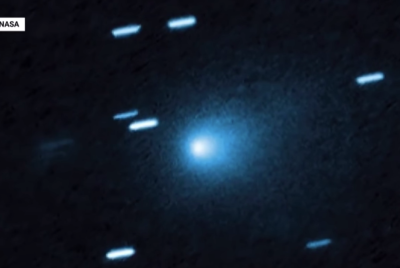Stunning Dawn Spectacle: Comet 3I/ATLAS Blazes Across The Morning Sky — Here's When And Where To Look
The third confirmed interstellar object, 3I/ATLAS, is now within reach of small telescopes — scientists explain why it matters and how to observe it.

A rare interstellar visitor, Comet 3I/ATLAS, has re-emerged into our morning skies, offering amateur astronomers and the scientifically curious a chance to glimpse material formed around another star.
The object, discovered by the ATLAS survey on 01 July 2025, is only the third confirmed interstellar body to traverse our Solar System and has been under intense scrutiny ever since. Scientists describe it as an active comet with a fuzzy coma and jets. Although it will never become naked-eye bright, it is now within reach of small telescopes and astrophotographers using long exposures.
How And When To See 3I/ATLAS From Britain
For UK observers, 3I/ATLAS is a morning object drifting through Virgo and, later, Leo; it rises in the east before dawn. Sky-watchers should aim for a low eastern horizon and arrive at least 45–60 minutes before local sunrise to let twilight remain faint enough for imaging or scope work. As of mid-November 2025, the comet's visual brightness is around magnitude +12, far too faint for the naked eye but accessible to medium-aperture amateur telescopes and camera rigs using 30–120 second exposures.
3I/ATLAS was caught on camera glowing brightly as it shot across the sky, once again without a visible tail.
— Space and Technology (@spaceandtech_) November 10, 2025
(captured by: Chuck’s Astrophotography)pic.twitter.com/iPSg7u8tcc
Practical steps for viewing:
- Use a star-chart or planetarium app (Stellarium, TheSkyLive) to lock on the comet's coordinates for the night in question;
- Choose a site with a flat, low eastern horizon;
- And, for photographers, stack multiple long exposures to bring out the diffuse coma and any faint tail structure.
The Sky At Night Magazine team has published maps and an up-to-date blog showing 3I's position and suggested framing for December nights when the object climbs nearer Regulus in Leo.
Discovery And Why It Matters
The Asteroid Terrestrial-impact Last Alert System (ATLAS) in Río Hurtado, Chile first detected 3I/ATLAS on 1 July 2025. Observatories worldwide quickly followed up. Its orbital solution is hyperbolic, a tell-tale sign that it originated beyond the Sun's gravitational dominion, making it the third object catalogued with the 'I' prefix after ʻOumuamua and 2I/Borisov. That interstellar provenance is what makes 3I scientifically priceless: it brings material from another planetary system into the range of modern instruments.
Spectroscopic and imaging campaigns, including observations by Hubble, Gemini, and the NASA SPHEREx mission, indicate a cometary nature: a small, icy nucleus surrounded by an outflowing coma and episodic jets of gas and dust.
Peer-reviewed analyses of its photometry and orbit show eccentricity and excess velocity consistent with an interstellar origin, and early papers have begun to estimate nucleus size and composition. These data let astronomers test models of planet formation in other stellar systems.
Science, Spacecraft, And Public Debate
3I/ATLAS's perihelion occurred at the end of October 2025, when several spacecraft, including Mars orbiters and NASA's Swift telescope, were tasked with observations while the comet briefly disappeared from Earth's daylight view. Swift's ultraviolet work and images returned by instruments on Mars have provided rare vantage points for studying the comet's gas production and composition as it warmed near the Sun. These multi-platform datasets are already delivering measurements of hydroxyl and other species that reveal water and volatile behaviour.
As with previous interstellar visitors, 3I/ATLAS has provoked both rigorous science and speculative commentary. Leading comet researchers such as Professor Darryl Seligman have discussed the object at length in recorded interviews, emphasising that the observable signatures, coma, jets, and spectral lines match cometary physics even if some measurements (for example, atypical nickel abundances or non-gravitational acceleration) remain topics for detailed analysis. Other voices have speculated about exotic explanations; scientists caution that extraordinary claims require extraordinary evidence and that the best route is more data and careful analysis.
Observational programmes and peer-reviewed studies now underway aim to nail down nucleus size estimates, isotopic ratios, and dust-to-gas ratios that can be compared with solar-system comets. Early releases suggest a nucleus on the order of kilometres across and a composition that includes water, carbon dioxide, and trace metals, precisely the sort of information that can tell us how common various planet-forming processes are across the Galaxy.
Beyond the headline-grabbing 'is it aliens?' questions, 3I/ATLAS is a once-in-a-generation chance to sample material that formed around a different star. For backyard astronomers, it is a technical challenge and photographic prize; for planetary scientists, it is a laboratory sample delivered by nature. Over the coming weeks, professional observatories and determined amateurs alike will continue to watch and measure this visitor before it vanishes back into the Milky Way.
Look east before dawn, train a telescope or camera on Virgo, and you may capture a faint smudge that once orbited another star, a tiny, ancient messenger from across the Galaxy.
© Copyright IBTimes 2025. All rights reserved.





















